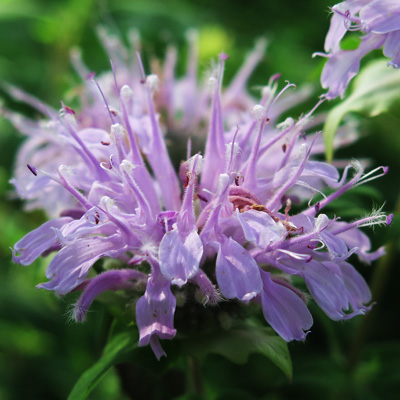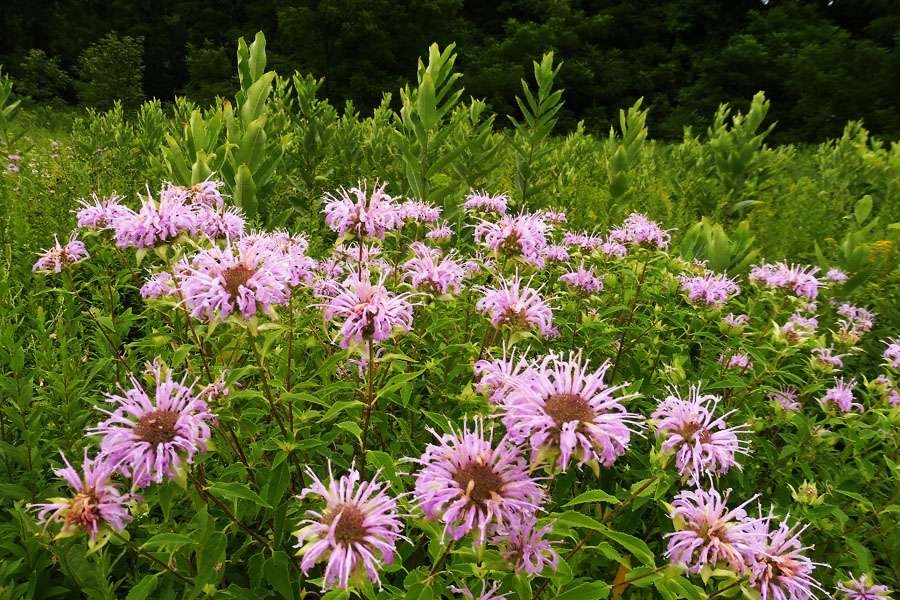
|
This article by Hubert Ling (NPSNJ horticulture) was published in Gardener's News without the photos. He is a regular contributing writer to Gardener's News. Photos by H & M Ling.
What native plant is used for butterfly kisses and for tea?
Wild Bergamot, Monarda fistulosa
What native plant is used for butterfly kisses and for tea? Why it's lavender/pink wild bergamot, Monarda fistulosa, which is one of the most versatile plants in your garden. To maximize your chances of getting butterfly kisses plan ahead.

First make sure you have several small groups of flowers preferably Monarda fistulosa scattered around your yard to attract butterflies. Second grow one larger group of Monarda near the center of your yard with a narrow path leading to the center of the clump and a chair placed in the middle, preferably one that can swivel. Then in July, when there are several butterflies around, occupy the seat, hold still, and wait. When butterflies arrive in the proximity of your face lean forward slowly and if you are lucky get your butterfly kisses. This has a chance of working because butterflies really love wild bergamot and may not perceive slow moving, large objects, as a threat.
Linnaeus used the plant's genus name, Monarda, to commemorate the 16th century Spanish botanist, Nicolas Bautista Monardes. The species name, fistulosa, comes from Latin fistula or tube which refers to the clustered, long tube like violet flowers which make up wild bergamot's flower heads; these showy flower heads are 2-4" in diameter. It really is a versatile mint and like most other mints has a prominent square stem.
Now about the tea. The Cherokee name for Monarda is gowugí which means "it smells (fragrant)". Because of this property two types of native NJ Monarda have been used by North American native people for tea for centuries. M. fistulosa is still used today by the Oneidas while M. didyma (bee balm or Oswego tea) is used as a traditional tea by neighboring tribes living near Oswego, NY. Monarda fistulosa was also used by several American Native Tribes including the Menominee, the Ojibwa, and the Winnebago to treat colds; this tea, often taken with honey, is still a popular treatment for colds. Commercially Earl Gray tea can be purchased with low or high concentrations of Monarda which can be a bit overpowering.
It is generally thought that Monarda tea was used to replace English tea after the Boston tea Party. Later tea was replaced by coffee which the colonists considered more patriotic.
Wild bergamot was also used by Native American tribes as an antibiotic poultice on pimples, skin infections, and minor wounds. They also used it to treat excessive flatulence and bergamot leaves were used to flavor meat and to scent hair pomade. The plant was also used for as incense in Native American saunas (sweat lodges); when used for your bath it will make your whole house fragrant. Bergamot oil has a number of active/aromatic ingredients; the best recognized of these is thymol which is a strong antiseptic and is featured as the active ingredient in commercial mouthwash.
Lavender/pink wild bergamot is an easy to grow, showy, reliable garden perennial; although you should plan to restart plants about every 5 years to insure a vigorous perennial bed. Plants are easily started by a shallow sowing of the minute seeds or by dividing mature clumps. The plant does well in slightly acid, neutral or slightly basic soils in partial shade or in moist, well drained sunny areas. The plants normally grow 2-4' tall and thus fit in almost anywhere in your garden.
View 2 short video clips of a clearwing hummingbird moth and a eastern tiger swallowtail working on getting nectar from wild bergamot flowers Video Clips
